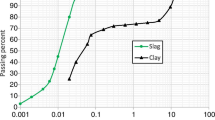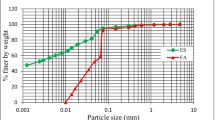Abstract
This paper studies the effects of sodium-based alkaline activators and class F fly ash on soil stabilisation. Using the unconfined compressive strength test (UCS), the effectiveness of this binder is compared with that of a common cement-based binder. Influence of the activator/ash ratio, sodium oxide/ash ratio and sodium hydroxide concentration was also analysed. Sodium hydroxide concentrations of 10, 12.5 and 15 molal were used for the alkaline-activated specimens (AA), with activator/ash ratios between 1 and 2.5 and ash percentages of 20, 30 and 40 %, relatively to the total solids (soil + ash). UCS was determined at curing periods of 7, 28, 90 and 365 days, and the most effective mixtures were analysed for mineralogy with XRD. The results showed a clear increase in strength with decreasing activator/ash ratio (up to a maximum of 43.4 MPa), which is a positive result since the activator is the most expensive component in the mixture. Finally, UCS results of the cement and AA samples, at 28 days curing, were very similar. However, AA results proved to be just between 20 and 40 % of the maximum UCS obtained at 1 year curing, while cement results at 28 days are expected to be between 80 and 90 % of its maximum.








Similar content being viewed by others
References
ASTM (2004) ASTM D6910 standard test method for marsh funnel viscosity of clay construction slurries. doi: 10.1520/D6910_D6910M-09
ASTM (2011) D2487-11 standard practice for classification of soils for engineering purposes (Unified Soil Classification System). doi: 10.1520/D2487-11
BSi (1990) BS 1377-2: 1990—methods of test for soils for civil engineering purposes, Part 2: classification tests. British Standards Institution, London 2
Chindaprasirt P, Jaturapitakkul C, Chalee W, Rattanasak U (2009) Comparative study on the characteristics of fly ash and bottom ash geopolymers. Waste Manag (New York, NY) 29(2):539–543
Chindaprasirt P, Chareerat T, Hatanaka S, Cao T (2011) High-strength geopolymer using fine high-calcium fly ash. J Mater Civ Eng 23(3):264
Criado M, Fernández-Jiménez A, de la Torre AG, Aranda MAG, Palomo A (2007) An XRD study of the effect of the SiO2/Na2O ratio on the alkali activation of fly ash. Cem Concr Res 37(5):671–679
Cristelo N, Glendinning S, Jalali S (2009) Sub-bases layers of residual granite soil stabilised with lime. Soils Rocks 32(2):83–88
Cristelo N, Glendinning S, Teixeira Pinto A (2011) Deep soft soil improvement by alkaline activation. Proc ICE Ground Improv 164(2):73–82
Duxson P, Provis JL, Lukey GC, Mallicoat SW, Kriven WM, van Deventer JSJ (2005) Understanding the relationship between geopolymer composition, microstructure and mechanical properties. Colloids Surf A: Physicochem Eng Aspects 269(1–3):47–58
Duxson P, Provis J, Lukey G, Vandeventer J (2007) The role of inorganic polymer technology in the development of “green concrete”. Cem Concr Res 37(12):1590–1597
EN B (1992) 1-1: 2004 Eurocode 2: design of concrete structures. General rules and rules for buildings (3)
Escalante-Garcia JI, Espinoza-Perez LJ, Gorokhovsky A, Gomez-Zamorano LY (2009) Coarse blast furnace slag as a cementitious material, comparative study as a partial replacement of Portland cement and as an alkali activated cement. Constr Build Mater 23(7):2511–2517
Essler R, Yoshida H (2004) Jet grouting. In: Moseley MP, Kirsch K (eds) Ground improvement, 2nd edn. Taylor & Francis, New York, pp 160–196
Fernández-Jiménez A, Palomo A (2003) Characterisation of fly ashes. Potential reactivity as alkaline cements. Fuel 82(18):2259–2265
Hadi NARA, Khoury HN, Suliman MR (2008) Utilization of bituminous limestone ash from EL-LAJJUN area for engineering applications. Acta Geotechnica 3(2):139–151
Hardjito D, Rangan BV (2005) Development and properties of low-calcium fly ash-based geopolymer concrete. Research Report GC 1. Perth
Hassett DJ, Heebink LV (2001) JV Task 13—environmental evaluation for utilization of ash in soil stabilisation, Final report. US Department of Energy, Pittsburgh
Hu M, Zhu X, Long F (2009) Alkali-activated fly ash-based geopolymers with zeolite or bentonite as additives. Cem Concr Compos 31(10):762–768
Janz M, Johansson S-E (2002) The function of different binding agents in deep stabilization. Report 9. Linkoping
Kasama K, Zen K (2007) High-strengthening of cement-treated clay by mechanical dehydration. Soils Found 47(2):171–184
Lee WK, van Deventer J (2004) The interface between natural siliceous aggregates and geopolymers. Cem Concr Res 34(2):195–206
Pacheco-Torgal F, Abdollahnejad Z, Camões AF, Jamshidi M, Ding Y (2012) Durability of alkali-activated binders: a clear advantage over Portland cement or an unproven issue? Constr Build Mater 30:400–405
Palomo A, Grutzeck M (1999) Alkali-activated fly ashes: a cement for the future. Cem Concr Res 29:1323–1329
Phair JW, Van Deventer JSJ (2002) Characterization of fly-ash-based geopolymeric binders activated with sodium aluminate. Ind Eng Chem Res 41(17):4242–4251
Temuujin J, Van Riessen A, MacKenzie KJD (2010) Preparation and characterisation of fly ash based geopolymer mortars. Constr Build Mater 24(10):1906–1910
Terashi M, Kitazume M (2011) QA/QC for deep-mixed ground: current practice and future research needs. Proc ICE Ground Improv 164(3):161–177
Tomlinson MJ (2001) Foundation Design and Construction. Pearson Education, Harlow
Van Jaarsveld JGS, Van Deventer JSJ (1999) Effect of the alkali metal activator on the properties of fly ash-based geopolymers. Ind Eng Chem Res 38(10):3932–3941
Villa C, Pecina ET, Torres R, Gómez L (2010) Geopolymer synthesis using alkaline activation of natural zeolite. Constr Build Mater 24(11):2084–2090
Winnefeld F, Leemann A, Lucuk M, Svoboda P, Neuroth M (2010) Assessment of phase formation in alkali activated low and high calcium fly ashes in building materials. Constr Build Mater 24(6):1086–1093
Xu H, Van Deventer JSJ (2000) The geopolymerisation of alumino-silicate minerals. Int J Miner Process 59:247–266
Xu H, Van Deventer JSJ (2003) Effect of source materials on geopolymerization. Ind Eng Chem Res 42(8):1698–1706
Author information
Authors and Affiliations
Corresponding author
Rights and permissions
About this article
Cite this article
Cristelo, N., Glendinning, S., Fernandes, L. et al. Effects of alkaline-activated fly ash and Portland cement on soft soil stabilisation. Acta Geotech. 8, 395–405 (2013). https://doi.org/10.1007/s11440-012-0200-9
Received:
Accepted:
Published:
Issue Date:
DOI: https://doi.org/10.1007/s11440-012-0200-9




